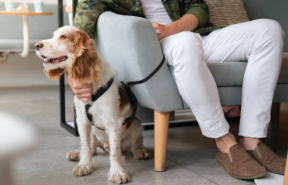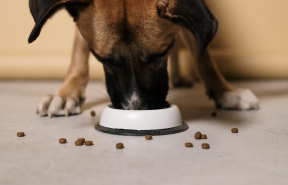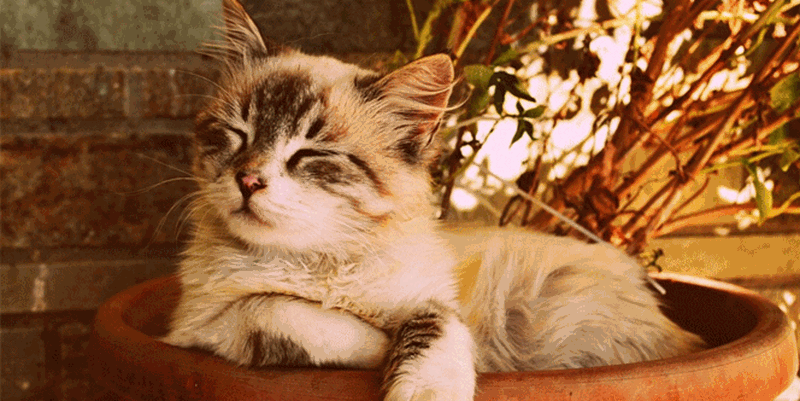Eating and Drinking
Changes in thirst and appetite are two areas that your vet will only know about if you report them. While some animals will get more fussy and others become less finicky as part of the general aging process, these things can also be an early marker for some disease problems. For example, a relatively common problem in older cats is hyperthyroidism. These cats will often be ravenous and eat very well but lose weight. Early treatment can save many complications. A very thirsty dog might have a number of problems, including diseases such as diabetes or kidney problems. So keep an eye on your older dog or cat's eating and drinking habits and report any changes to your vet.

Reduction in taste and smell sensations can contribute to poor appetites in older pets. Dividing the recommended daily feed amount into several small meals a day, warming the food and hand feeding some of the ration can help to keep the calorie intake up to normal.
Sight
Age can be associated with a loss of sensory capacity. Many animals will cope very well with being blind if they are in a familiar environment and the problem has developed slowly. Blindness that occurs suddenly can be more difficult for a dog or cat, as they have less time to adjust to vision loss. Providing certain scents to indicate particular environmental features can assist these pets.
For instance, a dot of lemon essence could be placed at the top of any stairs, a dot of eucalyptus oil adjacent to large pieces of furniture and so forth. If your pet needs to adjust to a new environment, then consider padding sharp protuberances in the short term, to reduce the risk of injury. Members of the household might choose to wear a bell so that the dog can track them in the household more effectively. Some eye problems can be painful and cause your pet to become depressed or aggressive. Be sure to have an eye examination by your vet if you have any concerns about your pet's vision.
Hearing
Deafness is a common problem for elderly dogs and cats. Sensitivity to certain pitches is often lost first. For this reason, it can be worth trying devices such as whistles, to attract attention if your pet fails to respond to your voice. Hearing may be lost on one side more than the other. This can result in your pet having difficulty in detecting where the noise has come from. Obviously, keeping your dog leashed on walks, taking extra care that your pet is not laying in the driveway when you come home (as he won't hear your arrival) and taking care not to startle them when asleep will reduce the risk of problems. Deaf dogs can be taught to respond to hand signals and tossing an item such as a small beanbag can gain the dog's attention. The dog can learn that whenever she sees a beanbag, she should look for you and a reward will be forthcoming. There are also owner-operated vibrating collars available. Dogs can be taught to look for their owner and then follow any hand signal given, at the feel of the harmless vibration. Obviously this relies on the dog having a reasonable sense of vision!
Older dogs that have no problems with their hearing may develop a fear of certain noises. Thunderstorms and fireworks are two of the more common sound phobias that may arise. The use of a CD of these noises (available from vets) and medications can be an important part of reducing the stress for your dog. However, growing older isn't all bad news. One benefit of becoming deaf is that some dogs, who have had difficulty with these noises in the past, now sleep through them blissfully unaware of any potential for stress!
Mobility Problems
Arthritis and other musculoskeletal problems can make it difficult for your pet to bound up those steps or jump on the couch the way he used to. Providing a step or two can help your cat to find that sunny spot he has always enjoyed. Ramps can be a great help for dogs who are having difficulty traversing up and down steps. Slippery floors such as polished boards or vinyl can also be like a skating rink for old, tired legs. Non-slip rubber runners can provide safe, secure footing. Elderly pets will often feel much more settled when settled down closely to their owner. They will be much less stressed if they don't have to traverse a slippery, frightening surface to reach you!
Slowing down for any reason means that your pet will be burning less fuel each day. This can predispose to obesity, which may exacerbate the initiating problem. Short periods of gentle exercise will help keep your pet interested in life and keep the heart and joints healthy. Swimming can be wonderful if your dog enjoys it. Only do as much exercise as your pet enjoys. Allow plenty of time to sniff the daisies. You wouldn't drag Grandma along at a pace she would struggle to cope with - so be sure not to do the same with your elderly canine companion. It's meant to be fun for both of you!
Providing additional warmth with wheat packs or heat pads, massage and appropriate medications can be beneficial for weary bodies running at a lower metabolic rate. Moving the heat pad around and hiding small amounts of dry food around the house are ways to encourage exercise in some feline couch potatoes.
There are many options to assist with the management of arthritis in both dogs and cats. If your pet is showing signs of joint pain and mobility problems, consult your vet about a treatment regime that can be tailored specifically for it.
Senility
It is now recognised that as dogs and cats age, some will develop problems that are analogous to dementia in people. This can result in some of the following symptoms: a reduced interest in interacting with owners and life in general, a loss of toilet training, reduced appetite, periods of staring into space, wandering aimlessly or vocalising for no apparent reason and disrupted sleep patterns.
These problems can impact severely on their quality of life. There are now medications available that can help to reduce these symptoms for many pets. It is important that owners recognise these symptoms as senility in their pet, rather than the normal process of aging.
Toileting Problems
Physical disorders can cause problems with toileting. Any disease that causes increased thirst and urination or tummy upsets can increase the chance of your pet soiling indoors. A thorough physical exam is a good starting point if your pet is having accidents. Some problems can be treated easily. For instance, incontinence can be resolved in some instances by giving a medication every now and again. Others can be more involved, so have a chat with your vet.
Make allowances for any physical limitations your pet may have. A pet with kidney problems may need to urinate through the night, so providing a dog door or extra kitty litter might be appropriate. A dog with severe arthritis may have difficulty making it outside in time, shifting her bed closer to an exit door or somewhere with fewer steps might help. You know your pet better than anyone. Take a walk in their paws and set them up to be able to toilet appropriately whenever possible.













